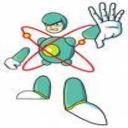Yahoo Answers is shutting down on May 4th, 2021 (Eastern Time) and beginning April 20th, 2021 (Eastern Time) the Yahoo Answers website will be in read-only mode. There will be no changes to other Yahoo properties or services, or your Yahoo account. You can find more information about the Yahoo Answers shutdown and how to download your data on this help page.
Trending News
Support cable question?
A 1 425-N uniform boom at ϕ = 69.0° to the vertical is supported by a cable at an angle θ = 21.0° to the horizontal as shown in the figure below. The boom is pivoted at the bottom, and an object of weight m = 2 400 N hangs from its top.
(a) Find the tension in the support cable._____
(b) Find the components of the reaction force exerted by the floor on the boom.
horizontal component magnitude ____ kN
vertical component magnitude _____ kN

2 Answers
- ?Lv 75 years agoFavorite Answer
=> will use "L" instead of lower case "L", as given in diagram, for boom length. T = Tension in support cable.
Torques {about the boom's pivot}:
ΣCW Torques = 2400(sin 21°)L + 1425(sin 21°)L/2 = 860L + 511(L/2) = 860L = 255L = 1115L
CCW Torque = T(3L/4) = 0.75TL
Equilibrium of Torques:
1115L = 0.75TL
T = 1115/0.75 = 1487 N ANS (a)
ΣFx = T(cos 21°) = 1487(cos 21°) = 1388 = 1.39 kN ANS (b)
ΣFy = 1425 + 2400 - T(sin 21°) = 3825 - 1487(cos 21°) = 2437 = 2.44 kN ANS (b)
- electron1Lv 75 years ago
To determine the tension in the cord, let do a torque problem, with the pivot point at hinge.
Counter clockwise torque = T * ¾ * L
For the boom, clockwise torque = 1425 * L/2 * cos 69
For the object, clockwise torque = 2400 * L * cos 69
Total clockwise torque = 1425 * L/2 * cos 69 + 2400 * L * cos 69
T * ¾ * L = 1425 * L/2 * cos 69 + 2400 * L * cos 69
Divide both sides by ¾ * L
T = 1900 * cos 69 + 3200 * cos 69 = 5100 * cos 69
This is approximately 1827.68 N. The tension has a vertical and horizontal component. To determine angle θ, subtract 69˚ from 90˚.θ = 21˚
Vertical = 5100 * cos 69 * sin 21
This is approximately 655 N. This is an upward force.
Horizontal = 5100 * cos 69 * cos 21
This is approximately 1706.3 N.
To determine the vertical component of reaction force, subtract this number from the total weight.
Total weight = 1425 + 2400 = 3825 N
Vertical component = 3825 – 5100 * cos 69 * sin 21 N
This is approximately 317 N.
There two horizontal forces. Since nothing is moving, these two forces are equal.
Horizontal component = 5100 * cos 69 * cos 21 N
You can round to kN.




